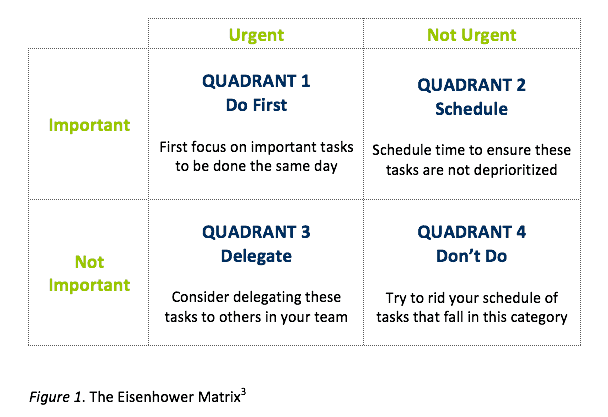Urgency vs Importance – Succession and the Eisenhower Principle
I have two kinds of problems, the urgent and the important. The urgent are seldom important, and the important are seldom urgent.
Dwight Eisenhower
In a survey of global executives, Deloitte finds that 86% of leaders consider succession planning “urgent” or “important,” but only 14% believe they do it well.[1] In fact, leadership is identified as the top human capital concern and the largest “readiness gap” across organizations. How is it that leaders understand the importance and need for succession planning, yet companies repeatedly fail to invest in a succession planning process?
Over the last 50 years SIGMA has worked with thousands of organizations across North America, and what leaders continuously tell us is that they struggle to plan for tomorrow because they can hardly keep up with the demands of today. The propensity for urgency taking precedence over impact is hardly new, and it’s been addressed by everyone from Stanford psychologists to the 34th President of the United States. Let’s take a look at what they have to say, the Eisenhower Principle, and how it applies to the succession planning process.
The Eisenhower Principle
In 1954, during a speech to the Second Assembly of the World Council of Churches, President Eisenhower quoted Dr J. Roscoe Miller, saying: “I have two kinds of problems: the urgent and the important. The urgent are not important, and the important are never urgent.” This became known as the “Eisenhower Principle,”[2] and was said to be how the former general of the United States Army, Allied Forces Supreme Commander, and first supreme commander of the North Atlantic Treaty Organization (NATO) [3] prioritized his tasks.
How the Principle Relates to Succession Planning
In the context of succession planning, the Eisenhower Principle can be used to explain why so many companies fail to build strong leadership pipelines, despite recognizing their necessity and value. Succession planning is always important, but it only becomes urgent when positions are vacated. At this point it’s too late to plan; companies need to resort to replacement hiring, which must often be done externally. Developing an internal talent pool requires a significant investment of time and effort. That is to say, it is a future-focused strategic process. Succession planning processes are rarely urgent, but they are always important. As such, they require disciplined execution and prioritization to avoid being eclipsed by the many urgent tasks that high level management will inevitably encounter in their day-to-day operations.
Urgency and Importance
To understand and apply the Eisenhower Principle, it’s important to know what qualifies as “urgent,” and what qualifies as “important.”
- Important activities are those which relate directly to an organization’s mission and vision. They are often strategic, long-term tasks with little immediate return on investment. Succession planning qualifies as an important activity because it will benefit the longevity and stability of a company.
- Urgent activities are those which demand our attention because the consequences of not dealing with them are immediate. Urgent activities are often less strategic and more task-oriented than impactful activities.
Applying the Eisenhower Matrix to Succession

Succession planning is an important, but often not very urgent task. That means the best way to go about it is to schedule the planning process (Quadrant 2). Make time for meetings in which you review critical roles in your company, discuss promising succession candidates, and establish development plans. Finally, consider hiring a third-party succession planning consultant to guide you through the planning process and hold you accountable for achieving your goals.
The Marshmallow Test
In addition to the former President of the United States, a trio of Stanford psychologists has also contributed to our understanding of the duality between urgency and impact.
In 1988, Mischel, Shoda, and Peake first administered what became known as the “Marshmallow Test”. This test was designed to examine children’s ability to delay gratification, and it demonstrated our tendency to prioritize immediate over long-term rewards. The test involved asking preschool children to wait in a room with a marshmallow and the instructions that they may eat the marshmallow now or save the marshmallow, receiving another one later and being allowed to eat two upon the researcher’s return.
The Marshmallow Test has been replicated many times over, and to this day young participants struggle to delay immediate gratification in favour of future reward. In the workplace, this principle is often what results in important tasks being overlooked. Our temptation to have immediate rewards (i.e. a completed task list for the day) outweighs our ability to out hold for long-term rewards (i.e. those associated with strategic planning).
Ready to Get Started?
Are you ready to start prioritizing your succession plan? At SIGMA, we offer custom succession planning, consulting, workshops, and resources. Take a look at our services or contact us below for more information on how we can help your leaders prepare for tomorrow.
[1] Stockton, H., Dongrie, V., Neveras, N. (March 7, 2014). Leaders at all levels: Close the gap between hype and readiness. Deloitte Insights. Retrieved from https://www2.deloitte.com/us/en/insights/focus/human-capital-trends/2014/hc-trends-2014-leaders-at-all-levels.html.
[2] MindTools. (200
[3] Eisenhower. (2020). Introducing the Eisenhower Matrix. Eisenhower. Retrieved from https://www.eisenhower.me/eisenhower-matrix/.